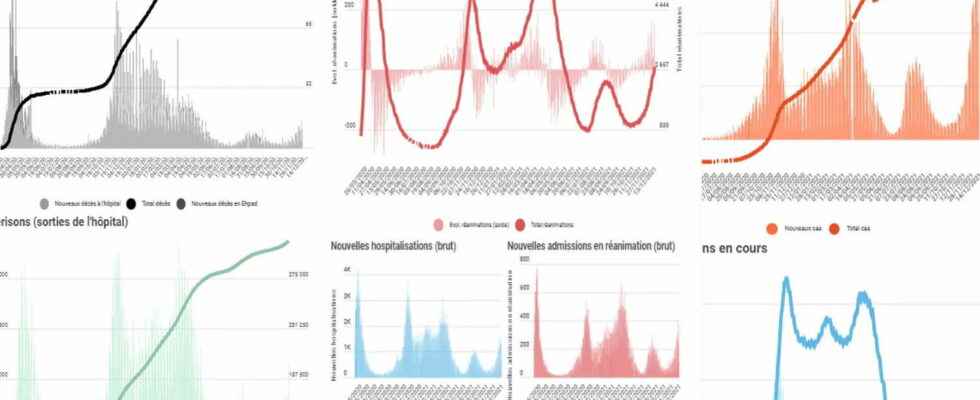COVID FRANCE FIGURES. Falling figures for the number of cases, for the first time in weeks, but a high number of deaths. This is the assessment of Covid-19 in France on July 12, 2022. The beginning of a decline must be confirmed in the next few days…
[Mis à jour le 12 juillet 2022 à 19h27] The latest assessment of the coronavirus in France, dated July 12, 2022, reports 182,006 cases in 24 hours, which is 24,548 cases less than last Tuesday. The 7-day average thus fell sharply on Tuesday, to 127,174 cases recorded daily, i.e. below the 130,000 cases that it had exceeded for several days. The incidence rate is also down slightly, to 1344.45 cases per 100,000 inhabitants in France currently (1344.87 yesterday).
On the other hand, the number of deaths with Covid recorded in 24 hours at the hospital is high this evening: 123 dead are to be deplored (excluding nursing homes), i.e. 15 more than yesterday and 48 more than last Tuesday. If the peak of the 7th wave of Covid in France was expected for this mid-July, we still have to wait for the next reports to confirm a decline. The impact on hospitals should for its part remain visible long after this peak of contamination.
In hospitals, there are indeed 19,160 hospitalized patients with Covid-19 on Tuesday, up 555 from yesterday, while 1158 people are in intensive care, or 51 more. Over the past 24 hours, 2,389 patients have been admitted to hospital, 594 more than the day before and 547 more compared to last Tuesday. 215 intensive care admissions were recorded, 39 more than yesterday and 57 more than last Tuesday.
A new law against Covid in France
Faced with this wave of Covid in France still in full dynamics, the Minister of Health François Braun solemnly called on the French “to civic-mindedness” Monday evening, during the opening of the debates in the Assembly on the new health bill. . He still recommends wearing a mask “in crowded places and on public transport”. But the government is holding its line for the moment, which dismisses any obligation.
If no firm restriction is on the agenda, a “health watch and security” bill began its journey in the National Assembly this week. He is supposed to find a follow-up to the state of health emergency, which will end on July 31. This new law on Covid should record the maintenance of tools for monitoring the epidemic, such as the SI-DEP system bringing together the results of screenings or the Tous Anti Covid application. It will also allow the government to set up a health pass at the country’s borders if the situation requires it. At stake: the obligation to provide a negative test, a vaccination or recovery certificate on arrival in the country.
The Covid law also provides for the creation of a new “committee for monitoring and anticipating health risks”. An entity dependent on the Minister of Health which will replace the Scientific Council and which will communicate its conclusions to the Presidents of the Assembly and the Senate. In its final report, the Scientific Council therefore indicated that it “will end its activities on July 31, 2022”.
Here is the latest official data available on Covid-19 in France according to the daily reports of Public health Francefrom its data site Geodes and of Data.gouv, based on data from SI-DEP tests, hospital data and feedback from medico-social establishments, including nursing homes. Many clarifications are necessary to properly understand these figures. They are detailed below the table:
PRECISION : since June 8, 2022, Public Health France and Data.gouv no longer provide data updates on weekends and public holidays. In addition, since January 16, 2022, the official publication of the total number of confirmed cases since the start of the epidemic (total accumulation) has been suspended “en due to an extension of the data consolidation period”, specifies Data.gouv. The first figure displayed above is therefore not an official figure, but comes from an accumulation carried out by us from non-consolidated data published daily via the SI-DEP database. Reinfections are counted as new cases.
Here is the number of cases of Covid-19, deaths, hospitalizations, resuscitations and cures observed in more or less compared to the previous assessment (generally the day before). Latest data available in France according to daily reports from Public Health France and Data.gouv:
Read also

New cases of covid, test positivity rate, share of the population tested… Linternaute offers you free access to data on the evolution of the epidemic in your municipality. See
From daily data on the coronavirus in France, we have developed several curves which allow us to observe the evolution of the virus according to the number of confirmed cases, the number of hospitalizations and patients in intensive care, the number of deaths in the hospital and total deaths and the number of returns home, assimilated to cures.
For the first graph, the curve represents the average of the cases recorded daily over 7 days while the bars represent the number of cases recorded in the last daily report. For the other graphs, the curve represents the total (e.g. total hospitalizations in progress) while the bars correspond to daily changes (balances of hospitalizations each day, new deaths, etc.).
Details on the number of cases: Public Health France specifies that “the data can be very variable depending on the screening activities (reduction of activities on weekends for example, mechanically lowering the number of cases on Monday) and the deadlines for reporting results” (generally 24 at 48 hours). Several changes in the method of recording positive tests may also have disrupted the accounting of cases:
- The government and Public Health France changed their method of collecting data on test results in mid-May 2020, with the SI-DEP project. The figures recorded before and after May 13, 2020 are therefore not completely comparable. Both the quantity and the nature of the tests carried out have greatly evolved. From a few thousand tests at the very start of the epidemic, France went to more than 1 million tests each week and then to 2 million at the start of November 2020, inevitably impacting the figures. In addition, at the height of the first wave, in March/April 2020, the tests mainly concerned seriously ill people, generally admitted to hospital, setting aside all patients with no or few symptoms. The actual number of Covid-19 cases in France was therefore quite significantly higher than the estimated number of confirmed cases during this period.
- Since mid-November 2020, the number of positive tests includes, in addition to PCR tests, the results of antigen tests.
- A duplicate correction was made by Public Health France on May 20, 2021. While there had been more than 5.9 million cases in France since the start of the epidemic, this figure was revised to nearly 5.57 million, or 348,846 fewer cases. A very visible correction on the curve above. others “incidents” on the flow of data have been reported several times by Public Health France.
Details on hospitalizations: it is necessary to distinguish here the evolution of the total number of patients hospitalized at a time T and the new hospitalizations, in other words the new admissions each day to the hospital (gross). In one case, it is a balance, which takes into account admissions, but also discharges from the hospital (healings or deaths). In the other, we are only talking about new admissions to hospital or intensive care with Covid over a day.
Hospitalization data also takes into account patients admitted to hospital “with” Covid-19 and not “for” Covid-19. They can therefore take into account patients hospitalized for another reason. Among all Covid-19 patients, the proportion of patients admitted to hospital for a reason other than Covid-19 (but carriers of SARS-CoV-2) may have reached up to a third of patients according to detailed data that Public Health France has made available since the end of January 2022.
Precision on the number of deaths: since May 2020, Public Health France no longer updates the balance sheet in Ehpad daily. This report was updated every week at the end of the summer, then several times a week to finally stabilize at a rate of once or twice a week. We therefore initially preferred to erase the number of daily deaths in nursing homes so as not to skew the graphs. At the request of several readers, since November 13, 2020, we are again displaying updates of deaths in nursing homes (dark gray bars) which causes artificial peaks during updates. Data errors and corrections have also been reported on several occasions by Public Health France since mid-March 2020 but also observed at the end of 2021, sometimes resulting in overestimates generally followed by negative changes in the number of deaths.
The Ministry of Health calculates, from the raw data, a series of statistics on the progression of Covid-19 in the country. Four particularly important indicators are presented below: the positivity rate of RT-PCR tests, the incidence rate, the effective reproduction number and the occupancy rate of intensive care beds. If the first and the last are easily understandable (percentage of positive tests out of the total number of tests carried out and percentage of intensive care beds occupied according to the initial capacities of the country), the other two deserve a definition.
The incidence rate, represented by the second curve, is considered a key indicator of the virulence of the virus. This is the number of new cases of coronavirus diagnosed by PCR test that have occurred over the past 7 days. This figure is related to the number of inhabitants, ie a rate expressed per 100,000 inhabitants.
The reproduction number (R) corresponds to the average number of people infected by a patient. If this figure is greater than 1, it means that a person with Covid-19 infects more than one other person on average and therefore that the disease is progressing.
If you don’t see the infographic, Click here
Precision on the positivity rate and the incidence rate: Public Health France changed its calculation method for its main indicators, which are the incidence rate and the test positivity rate on December 8, 2020. The addition of antigenic tests in the first indicator then mechanically inflated the result of the calculation. . The positivity rate has dropped drastically. The reason this time comes from the counting of negative tests: if the same person has carried out several tests within 60 days and these are negative, each of them is now counted. Previously, if a person tested negative several times in a row within 60 days, only the first test was counted. It was only in the event of a positive test that his situation changed.
Public Health France explained in a press release that this new method of calculation proved to be more precise because it takes into account the “prevalence of the virus in the population tested”. “Today, as the epidemic continues, it is common for the same person to carry out several tests, especially when the previous ones were negative. In addition, knowledge has evolved and the risk of reinfection, which today is considered very low but possible after 60 days, must be able to be identified”, wrote the health agency at the time.
